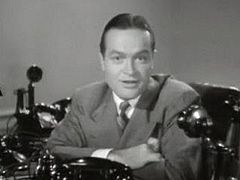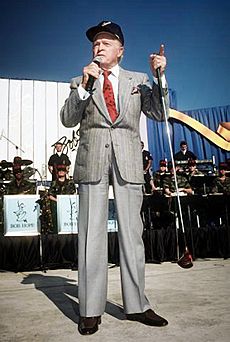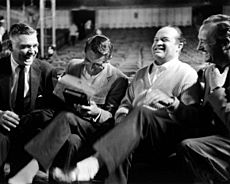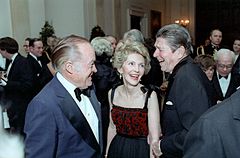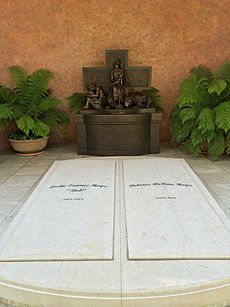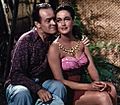Bob Hope facts for kids
Quick facts for kids
Bob Hope
|
|||||||||||||||||
|---|---|---|---|---|---|---|---|---|---|---|---|---|---|---|---|---|---|
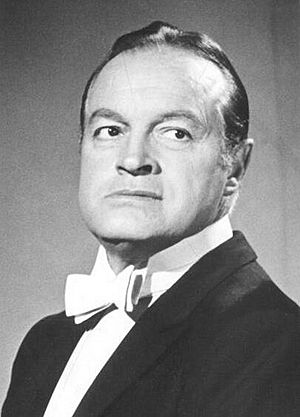
Hope in a 1969 publicity photo
|
|||||||||||||||||
| Born |
Leslie Townes Hope
May 29, 1903 |
||||||||||||||||
| Died | July 27, 2003 (aged 100) Los Angeles, California, U.S.
|
||||||||||||||||
| Resting place | San Fernando Mission Cemetery | ||||||||||||||||
| Nationality | American | ||||||||||||||||
| Other names |
|
||||||||||||||||
| Occupation |
|
||||||||||||||||
| Years active | 1924–1998 | ||||||||||||||||
| Spouse(s) |
|
||||||||||||||||
| Children | 4 | ||||||||||||||||
| Relatives | Jack Hope (brother) | ||||||||||||||||
| Awards | Full list | ||||||||||||||||
|
|||||||||||||||||
| Musical career | |||||||||||||||||
| Genres |
|
||||||||||||||||
| Instruments | Vocals | ||||||||||||||||
| Signature | |||||||||||||||||
Leslie Townes "Bob" Hope (May 29, 1903 – July 27, 2003) was a famous American comedian, actor, and entertainer. His amazing career lasted almost 80 years! He was known for his work in live shows, radio, television, and especially for entertaining soldiers around the world with the United Service Organizations (USO).
Bob Hope appeared in over 70 films, starring in 54 of them. He was famous for his "Road to ..." musical comedy movies with his good friend Bing Crosby. He also hosted the Academy Awards (the Oscars) a record 19 times! Hope wrote 14 books, and his signature song was "Thanks for the Memory".
Born in London, England, Bob Hope moved to the United States with his family when he was four. He grew up in Ohio. He started as a boxer in his teens but soon switched to show business in the 1920s. He began as a comedian and dancer in vaudeville shows, then moved to Broadway. He started appearing on radio and in films in 1934. People loved his quick jokes and funny one-liners.
From 1941 to 1991, Hope went on 57 tours for the USO. He entertained military personnel all over the world. In 1997, the U.S. Congress even made him an honorary veteran of the Armed Forces. Bob Hope retired from public life in 1998 and passed away in 2003, at the age of 100.
Contents
Bob Hope's Early Life
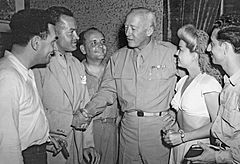
Leslie Townes Hope was born on May 29, 1903, in Eltham, London, England. He was the fifth of seven sons. His father, William Henry Hope, was a stonemason, and his mother, Avis, was a singer. His family moved to the United States in 1908, settling in Cleveland, Ohio.
From age 12, Bob Hope earned money by singing, dancing, and telling jokes on the street. He entered many talent contests as "Lester Hope". In 1915, he won a prize for pretending to be Charlie Chaplin. He even had a short career as a boxer in 1919, fighting under the name "Packy East". He won three fights and lost one.
In his early 20s, Hope worked different jobs, like a butcher's assistant. In 1921, he had an accident while clearing trees that injured his face. This required surgery and contributed to his unique look later on.
Hope started dancing lessons and soon formed a comedy and dance act with a friend, Lloyd Durbin. They were discovered by silent film comedian Fatty Arbuckle. Later, Hope formed an act called the "Dancemedians". In 1929, he informally changed his first name to "Bob". He liked the name because it sounded "friendly".
Bob Hope's Amazing Career
Bob Hope's career began on stage in vaudeville shows and Broadway plays. He started performing on the radio in 1934. When television became popular in the 1950s, he moved to that medium. He hosted many TV specials starting in 1954. He also hosted the Academy Awards (the Oscars) 19 times between 1939 and 1977. His movie career lasted from 1934 to 1972, and his famous USO tours were from 1941 to 1991.
Movies and the "Road" Films
Bob Hope signed a contract for six short comedies. His first film was Going Spanish (1934). He wasn't happy with it! He soon signed with another studio, Vitaphone, making musical and comedy shorts.
Hope moved to Hollywood when Paramount Pictures signed him for the 1938 film The Big Broadcast of 1938. In this movie, he sang "Thanks for the Memory" with Shirley Ross. This song later became his famous trademark tune. His writers would often change the lyrics to fit different situations, like saying goodbye to troops or mentioning towns he was visiting.
As a movie star, Hope was best known for comedies like My Favorite Brunette and the very popular "Road" movies. He starred in these films with Bing Crosby and Dorothy Lamour. There were seven "Road" films made between 1940 and 1962. Hope and Crosby worked together easily because they had performed together on stage years before.
Dorothy Lamour was a nightclub singer whom Hope invited to join his USO tours. She was often surprised when scripts were rewritten on the spot by Hope and Crosby! Hope and Lamour were lifelong friends.

After the first "Road" movie, Road to Singapore (1940), Hope's movie career really took off. He starred in 54 movies between 1938 and 1972. His later movies weren't as successful as his earlier ones. His last main film was Cancel My Reservation (1972). He did make a few small appearances in films in the 1980s.
Bob Hope hosted the Academy Awards ceremony 19 times. He often joked about wanting an Oscar himself. Even though he was never nominated for a competitive Oscar, the Academy gave him four special honorary awards. In 1960, he received the Jean Hersholt Humanitarian Award for his good deeds.
Radio and Television
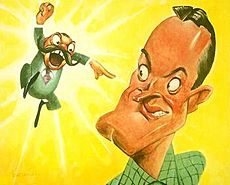
Hope's broadcasting career started on radio in 1934. His first regular show for NBC Radio was the Woodbury Soap Hour in 1937. A year later, The Pepsodent Show Starring Bob Hope began. This show became the top radio program in the country! Hope hired many writers to help him with his jokes. He continued his successful radio career into the 1950s.

When television became popular, Hope moved to TV. He did many specials for the NBC network, starting in April 1950. He was one of the first people to use cue cards (large cards with lines written on them). His Christmas specials were very popular. He often sang "Silver Bells" with a younger female guest star or with his wife, Dolores.
His 1970 and 1971 Christmas specials, filmed in Vietnam for soldiers, were watched by more than 60% of U.S. households!
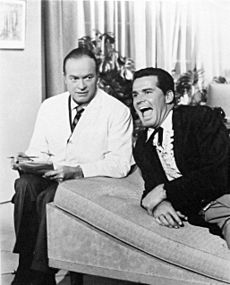
Bob Hope's Comic Books
In 1950, Bob Hope even had his own comic book series called The Adventures of Bob Hope. It was published by DC Comics. The comic featured fictional stories, sometimes including made-up relatives or even a superhero called Super-Hip! The series ran until 1969.
Entertaining the Troops (USO)
Bob Hope's most famous work was entertaining military personnel. He performed his first USO show on May 6, 1941, in California. He continued to travel and entertain troops during World War II, the Korean War, the Vietnam War, and even the Gulf War. His USO career lasted for 50 years, and he led 57 tours!
He deeply respected the men and women in the armed forces. He was willing to go anywhere to make them laugh. During the Vietnam War, it was sometimes hard to find performers to join him. But he always went, showing his support for the troops.
Hope often brought his family members on these tours. His wife, Dolores, sang from an armored vehicle during the Desert Storm tour. Even his granddaughter Miranda performed with him. Novelist John Steinbeck, who was a war correspondent, wrote in 1943 that Bob Hope should be highly recognized for his service during wartime.
For his amazing service, he received the Sylvanus Thayer Award from the United States Military Academy at West Point in 1968. He was the first entertainer to get this award. In 1997, Congress named him an "Honorary Veteran." He said this was the greatest honor he ever received.
Stage Performances
Hope's first appearances on Broadway were small roles in 1927 and 1928. He returned to Broadway in 1933 to star in the musical Roberta. He also performed in the 1936 Ziegfeld Follies and Red, Hot and Blue.
Bob Hope also helped save the Eltham Little Theatre in England by providing money to buy the building. The theater was renamed in his honor in 1982.
Later Appearances and Legacy
Bob Hope continued to make guest appearances on TV shows. In 1989, he was on The Golden Girls. In 1992, he appeared as himself on The Simpsons. His 90th birthday TV celebration in 1993 won an Emmy Award.
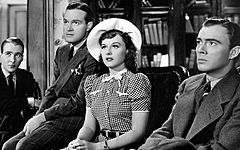
Hope was known for his amazing comedic timing and quick one-liner jokes. He often used self-deprecating humor, meaning he would make fun of himself. His early films like The Cat and the Canary (1939) were very successful. By the mid-1940s, he was one of the most popular entertainers in the United States.

Even as Hollywood changed, Hope stuck to his classic style of comedy. He continued his USO tours into the 1980s and appeared on television into the 1990s. Former First Lady Nancy Reagan called him "America's most honored citizen and our favorite clown."
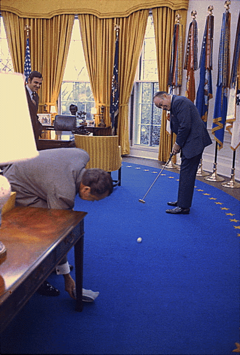
Bob Hope was also a very enthusiastic golfer. He played in many charity tournaments. He even used a golf club as a prop during his stand-up comedy routines. In 1978, he putted against a two-year-old Tiger Woods on a TV show! The Bob Hope Classic golf tournament, founded in 1960, was named after him. In 1995, Hope played in a foursome with three U.S. Presidents: Gerald Ford, George H. W. Bush, and Bill Clinton.
Hope also had a strong interest in other sports. He owned a small part of the Cleveland Indians baseball team for many years. He also owned a share of the Los Angeles Rams football team with Bing Crosby. He often promoted the annual College Football All-America Team on his TV specials.
Bob Hope's Family Life
Bob Hope was briefly married to Grace Louise Troxell from 1933 to 1934.
His next partner was singer Dolores Reade, who was also a Broadway co-star. They adopted four children: Linda, Tony, Kelly, and Eleanora (Nora). Bob and Dolores also became the legal guardians of Tracey Shor. In 1937, they moved to Toluca Lake, Los Angeles, where they lived for the rest of their lives.
Helping Others
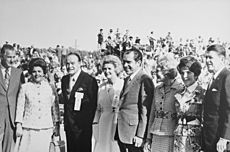
Bob Hope had vision problems for much of his life. He was an active honorary chairman for Fight for Sight, an organization that funds medical research for vision. He hosted their "Lights On" telecast in 1960 and donated a large sum of money to help. He also got many other celebrities to join the annual fundraiser.
Bob Hope's Last Years
Bob Hope continued his active career even past his 90th birthday. He focused on his TV specials and USO tours. For his 80th birthday in 1983, a special celebration was held with President Ronald Reagan and other stars. In 1985, he received the Life Achievement Award at the Kennedy Center Honors. In 1998, Queen Elizabeth II made him an honorary Knight Commander of the Most Excellent Order of the British Empire (KBE).
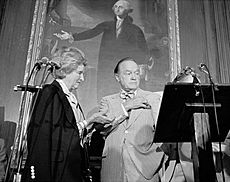
Hope celebrated his 100th birthday on May 29, 2003. To mark this special day, an intersection in Hollywood, Los Angeles, was named "Bob Hope Square." His 100th birthday was also declared "Bob Hope Day" in 35 states. Even at 100, he kept his sense of humor, joking, "I'm so old, they've canceled my blood type."
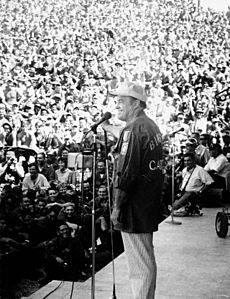
Bob Hope passed away from pneumonia at his home in California on July 27, 2003, two months after his 100th birthday. His grandson said that when asked where he wanted to be buried, Hope told his wife, "Surprise me." He was buried at the San Fernando Mission Cemetery. After his death, cartoonists around the world honored his work for the USO. Many drew pictures of Bing Crosby, who had died in 1977, welcoming Hope to Heaven.
Awards and Honors
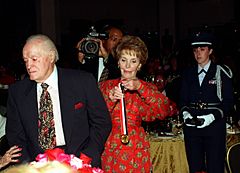
Bob Hope received over 2,000 honors and awards during his lifetime. These included 54 honorary university doctorates!
- In 1963, President John F. Kennedy gave him the Congressional Gold Medal.
- In 1969, President Lyndon Johnson gave him the Presidential Medal of Freedom for his service to the armed forces.
- In 1995, he received the National Medal of Arts.
- In 1997, he received the Ronald Reagan Freedom Award.
- In 1980, he became the only civilian to receive the United States Air Force Order of the Sword.
Several places were renamed in his honor, including the Bob Hope Airport in Burbank, California. There is also a Bob Hope Gallery at the Library of Congress. The U.S. Navy ship USNS Bob Hope (T-AKR-300) was named after him in 1997. This is special because very few U.S. naval ships are named after living people.
In his hometown of Cleveland, the Lorain-Carnegie Bridge was renamed the Hope Memorial Bridge in 1983. East 14th Street in Cleveland's theater district was renamed Memory Lane-Bob Hope Way in 2003 for his 100th birthday.
Academy Awards
Even though he was never nominated for a competitive Oscar, Bob Hope received five special honorary awards from the Academy of Motion Picture Arts and Sciences:
- 1940: Special Award for his services to the movie industry.
- 1944: Special Award for his many services to the Academy.
- 1952: Honorary Award for bringing laughter to the world and serving the movie industry.
- 1959: Jean Hersholt Humanitarian Award for his humanitarian efforts.
- 1965: First Academy Gold Medal for unique and distinguished service to the industry.
Bob Hope's Music
Singles
| Year | Single | US Pop Chart |
|---|---|---|
| 1936 | "De-Lovely" | -- |
| 1938 | "Thanks for the Memory" (Oscar for Best Original Song) (Bob Hope and Shirley Ross) | -- |
| 1939 | "Two Sleepy People" (B-side) (Bob Hope and Shirley Ross) | 15 |
| 1945 | "(We're Off on the) Road to Morocco" (Bing Crosby and Bob Hope) | 21 |
| 1948 | "Buttons and Bows" (Oscar for Best Original Song) | -- |
| 1950 | "Blind Date" (Margaret Whiting and Bob Hope) | 16 |
| 1951 | "Silver Bells (Christmas song) | -- |
Images for kids
-
Hope with Dorothy Lamour in Road to Bali (1952)
See also
 In Spanish: Bob Hope para niños
In Spanish: Bob Hope para niños
- Bob Hope bibliography
- Bob Hope television specials


